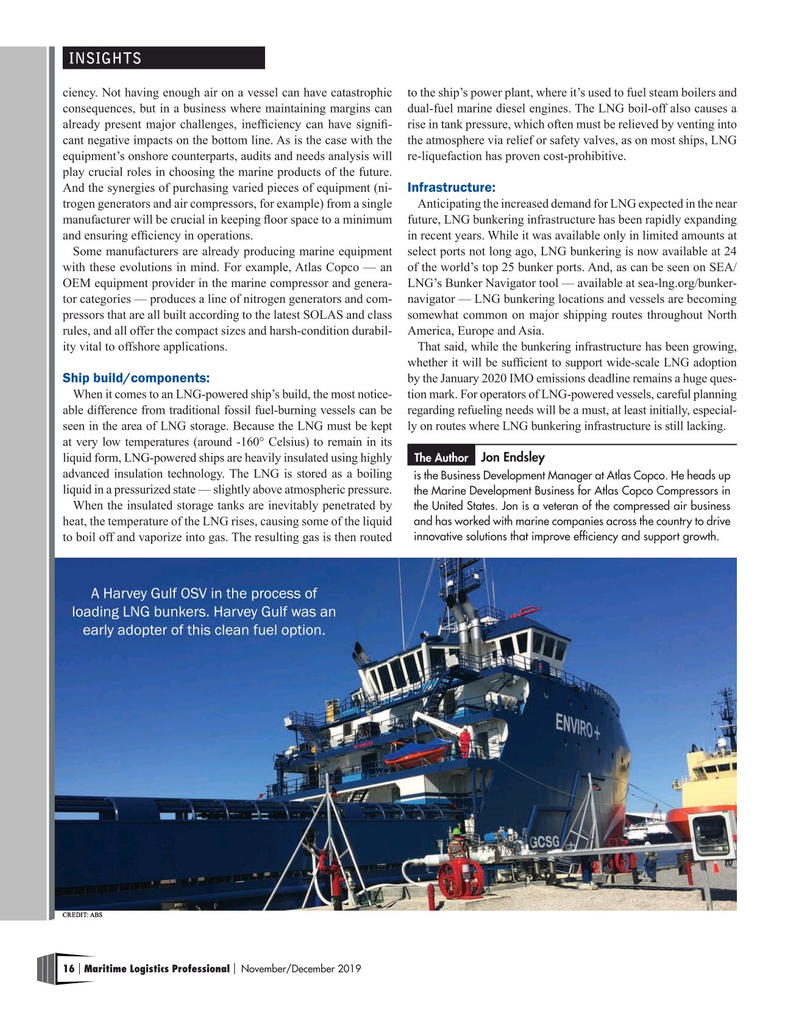
Page 16: of Maritime Logistics Professional Magazine (Nov/Dec 2019)
Short Sea Shipping Ports
Read this page in Pdf, Flash or Html5 edition of Nov/Dec 2019 Maritime Logistics Professional Magazine
INSIGHTS ciency. Not having enough air on a vessel can have catastrophic to the ship’s power plant, where it’s used to fuel steam boilers and consequences, but in a business where maintaining margins can dual-fuel marine diesel engines. The LNG boil-off also causes a already present major challenges, ineffciency can have signif- rise in tank pressure, which often must be relieved by venting into cant negative impacts on the bottom line. As is the case with the the atmosphere via relief or safety valves, as on most ships, LNG equipment’s onshore counterparts, audits and needs analysis will re-liquefaction has proven cost-prohibitive.
play crucial roles in choosing the marine products of the future.
And the synergies of purchasing varied pieces of equipment (ni- Infrastructure: trogen generators and air compressors, for example) from a single Anticipating the increased demand for LNG expected in the near manufacturer will be crucial in keeping foor space to a minimum future, LNG bunkering infrastructure has been rapidly expanding and ensuring effciency in operations. in recent years. While it was available only in limited amounts at
Some manufacturers are already producing marine equipment select ports not long ago, LNG bunkering is now available at 24 with these evolutions in mind. For example, Atlas Copco — an of the world’s top 25 bunker ports. And, as can be seen on SEA/
OEM equipment provider in the marine compressor and genera- LNG’s Bunker Navigator tool — available at sea-lng.org/bunker- tor categories — produces a line of nitrogen generators and com- navigator — LNG bunkering locations and vessels are becoming pressors that are all built according to the latest SOLAS and class somewhat common on major shipping routes throughout North rules, and all offer the compact sizes and harsh-condition durabil- America, Europe and Asia.
ity vital to offshore applications. That said, while the bunkering infrastructure has been growing, whether it will be suffcient to support wide-scale LNG adoption by the January 2020 IMO emissions deadline remains a huge ques-
Ship build/components:
When it comes to an LNG-powered ship’s build, the most notice- tion mark. For operators of LNG-powered vessels, careful planning able difference from traditional fossil fuel-burning vessels can be regarding refueling needs will be a must, at least initially, especial- seen in the area of LNG storage. Because the LNG must be kept ly on routes where LNG bunkering infrastructure is still lacking.
at very low temperatures (around -160° Celsius) to remain in its liquid form, LNG-powered ships are heavily insulated using highly Jon Endsley
The Author advanced insulation technology. The LNG is stored as a boiling is the Business Development Manager at Atlas Copco. He heads up liquid in a pressurized state — slightly above atmospheric pressure. the Marine Development Business for Atlas Copco Compressors in
When the insulated storage tanks are inevitably penetrated by the United States. Jon is a veteran of the compressed air business and has worked with marine companies across the country to drive heat, the temperature of the LNG rises, causing some of the liquid innovative solutions that improve effciency and support growth.
to boil off and vaporize into gas. The resulting gas is then routed
A Harvey Gulf OSV in the process of loading LNG bunkers. Harvey Gulf was an early adopter of this clean fuel option.
CREDIT: ABS 16 Maritime Logistics Professional November/December 2019 | |

 15
15

 17
17
